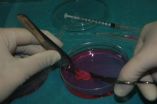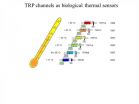(Press-News.org) A young woman has become the first in the world to give birth to a healthy child after doctors restored her fertility by transplanting ovarian tissue that had been removed and frozen while she was a child.
A report of the case is published today in Human Reproduction [1], one of the world's leading reproductive medicine journals. While there have been reports of successful pregnancies after ovarian transplantation using tissue that had been removed from patients when they were adults, there have been none using tissue taken from girls before puberty and the ability of such immature ovarian tissue to develop to produce mature eggs is unclear.
The patient, who was born in the Republic of Congo, was diagnosed with sickle-cell anaemia when she was five. After emigrating to Belgium at the age of 11, doctors decided that her disease was so severe that she should be treated with a bone marrow transplant, and her brother was able to provide the matching tissue. The procedure requires that the patient's immune system should be disabled before transplantation to prevent rejection of the bone marrow and this is usually done using chemotherapy or radiotherapy, which can destroy the functioning of the ovaries permanently.
Therefore, before treating her with chemotherapy, the Belgian doctors removed the patient's right ovary when she was 13 years and 11 months old and froze tissue fragments. She had not started her periods, although there were signs that she had started puberty with breast development when she was 10.
The bone marrow transplant was successful, although the patient developed graft-versus-host disease and had to continue with immuno-suppressive drugs for 18 months after the transplant. Her remaining ovary failed and when she was 15, doctors gave her hormone replacement therapy to induce the onset of menstruation.
Ten years later the patient received counselling after expressing a desire to become pregnant. In order to restore her fertility, doctors led by Dr Isabelle Demeestere, a gynaecologist and research associate in the Fertility Clinic and Research Laboratory on Human Reproduction at Erasme Hospital, Université Libre de Bruxelles (Brussels, Belgium), stopped the hormone replacement therapy, thawed some, but not all, of the frozen ovarian tissue and grafted four fragments on to the remaining left ovary, and 11 other fragments at other sites in the body.
The transplanted tissue started to respond to her hormones and successfully started growing follicles that contain the maturing eggs. The patient started menstruating five months later and continued having regular menstrual cycles thereafter. Due to the infertility of her partner, she tried assisted reproduction but stopped when the relationship failed. More than two years after the transplantation she became pregnant naturally with a new partner at the age of 27 and delivered a healthy boy in November 2014, weighing 3140 grams (6.9 pounds).
Dr Demeestere said: "This is an important breakthrough in the field because children are the patients who are most likely to benefit from the procedure in the future. When they are diagnosed with diseases that require treatment that can destroy ovarian function, freezing ovarian tissue is the only available option for preserving their fertility.
"However, the success of this procedure requires further investigation in very young, pre-pubertal girls, as our patient had already started puberty even although she had not started menstruating. In addition, the procedure also raises some controversial issues. For instance, because it is an invasive procedure and because the lifespan of the graft is limited, should it be used to induce puberty and menstruation, rather than to restore fertility, when hormone replacement therapy is an efficient, standard, and non-invasive alternative for inducing puberty? Should the procedure only be proposed for patients with a high risk of ovarian failure or for those at low risk as well? We think, at present, that cryopreserved ovarian tissue should be used only for fertility restoration in patients at high risk of ovarian failure, and not for puberty induction or for restoring menstrual cycles in adults."
The patient's ovary continues to function normally and her doctors say there is no reason why she could not have more babies if she wants to. "She also has the possibility of undergoing a second transplantation with the remaining frozen tissue if the graft stops working, as we didn't transplant all the ovarian tissue the first time. We have another patient who became pregnant after ovarian transplantation, and she had two babies born after two graft procedures," said Dr Demeestere.
INFORMATION:
[1] "Live birth after autograft of ovarian tissue cryopreserved during childhood", by Isabelle Demeestere et al. Human Reproduction journal. doi:10.1093/humrep/dev128
Scientists at the University of Liverpool have shown that the most complete giant sauropod dinosaur, Dreadnoughtus, discovered by palaeontologists in South America in 2014, was not as large as previously thought.
Found in Patagonia, the huge fossil had almost all of the major bones intact, allowing scientists to confidently estimate its overall size - measuring in at 26 metres long.
Preserved in rock, it is thought that the animal was close to maturity but not fully grown when it died, and may have grown to be even larger. The long-necked, plant-eating dinosaur was ...
Having a hierarchical social structure with just a few well-connected leaders enables pigeon flocks to navigate more accurately on the wing, new research shows.
Hierarchical organisation also enables flocks to cope better with navigation errors made by individual birds.
Researchers from Oxford University and the Zoological Society of London created 'virtual flocks' of homing pigeons to test how different social networks affect the navigation performance of these groups. The team's simulations looked at everything from no networks (all connections between individuals ...
A single dose of the bivalent human papillomavirus (HPV) vaccine (Cervarix®, GlaxoSmithKline group of companies) may offer a similar level of protection against HPV-16/18 infections, which cause about 70% of cervical cancers, as the current two- and three-dose schedules, according to new research combining data from two large phase 3 trials published in The Lancet Oncology.
"Our findings question the number of HPV vaccine doses truly needed to protect the majority of women against cervical cancer, and suggest that a one-dose schedule should be further evaluated. ...
NEW YORK, June 9 -- The World Health Organization released its 2015 updated essential medicines list and for the first time included the progesterone contraceptive vaginal ring (CVR), a contraceptive safe and effective for lactating women in the postpartum period.
The progesterone CVR, developed by the Population Council, is an intravaginal ring that provides women who breastfeed at least four times a day with a contraceptive option as early as four weeks after giving birth. It can be used for up to a year for improved birth spacing.
'More than 220 million women in ...
UC Davis researchers have identified the molecular interactions that allow capsaicin to activate the body's primary receptor for sensing heat and pain, paving the way for the design of more selective and effective drugs to relieve pain. Their study appeared online June 8 in the journal Nature Chemical Biology.
Capsaicin is the ingredient that makes chili peppers spicy and hot. The same pathway in the body that responds to spicy food is also activated after injury or when the immune system mounts an inflammatory response to bacteria, viruses, or in the case of autoimmune ...
Our sun is a volatile star: explosions of light, energy and solar materials regularly dot its surface. Sometimes an eruption is so large it hurls magnetized material into space, sending out clouds that can pass by Earth's own magnetic fields, where the interactions can affect electronics on satellites, GPS communications or even utility grids on the ground.
The clouds can be large or small. They can be relatively slow or as fast as 3,000 miles per second, but only one component has a strong effect on how much a CME will arrange the magnetic fields in near-Earth space. ...
Researchers at the University of Pennsylvania have found a three to five percent reduction in the probability of criminal recidivism among a sample of juveniles arrested for felony drug offenses, some of whom were processed as adults due to their age at the time of their arrests.
In a study published in the Journal of Research in Crime and Delinquency, Charles Loeffler, an assistant professor of criminology in the School of Arts & Sciences and Ben Grunwald, a doctoral candidate in the criminology department, analyzed the effect of processing juveniles as adults using ...
For engine designers in the digital age, time is money. And that time is measured in computer cycles.
Researchers at the U.S. Department of Energy's Argonne National Laboratory are partnering with Convergent Science, Inc. (CSI), to speed up a key piece of modeling and simulation software to ensure those cycles are used as effectively as possible, reducing product development time and resulting in better engines and savings for consumers. The scale of the speed gains were recently demonstrated when researchers ran the largest engine simulation to date on more than 4,000 ...
Irvine, Calif., June 9 -- Brain inflammation caused by chronic nerve pain alters activity in regions that regulate mood and motivation, suggesting for the first time that a direct biophysical link exists between long-term pain and the depression, anxiety and substance abuse seen in more than half of these patients, UC Irvine and UCLA researchers report.
This breakthrough finding also points to new approaches for treating chronic pain, which is second only to bipolar disorder among illness-related causes of suicide. About a quarter of Americans suffer from chronic pain, ...
MAYWOOD, Ill. -- Brain lesions in children can be especially challenging to diagnose, according to a report in the journal Frontiers in Neurology by a multidisciplinary team of Loyola University Medical Center physicians.
Lesions include tumors, abnormal blood vessel formations and abscesses and inflammation due to infections.
In the pediatric population, such lesions 'can have a large variety of underlying etiologies (causes), which can be challenging to differentiate on neuroimaging,' lead author Marisa McGinley, M.D., and colleagues report.
The Loyola physicians ...





